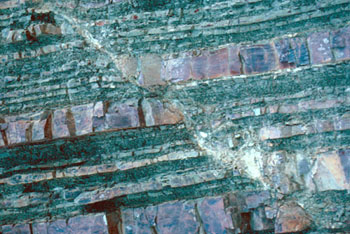Earthquakes
The outer, rigid layer of the Earth
What is the lithosphere?
A volcanic mud flow consisting of ash water, and debris
What is a lahar?
Which seismic waves cause the most destruction?
What are the surface waves?
Features that form at an oceanic-continental convergent boundary
What are trenches and volcanoes?
This type of fault:

What is a normal fault?
The composition of the asthenosphere.
What is mantle?
Hot, gravity driven flow of ash and gas travelling down valleys at very high speed
What is a pyroclastic flow?
The seismic wave with particle motions perpendicular to the direction the wave is moving
What are S-waves?
Feature that forms at a continental-continental convergent boundary
What are mountains?
This type of fault:

What is a right-lateral strike slip fault?
A mechanical layer of the Earth that behaves as a liquid.
What is the outer core?
The four primary types of volcanic edifices
What are scoria cones, stratovolcanoes, shield volcanoes, and dome complexes?
A phenomena that causes buildings to sway intensely.
What is resonance?
A type of plate boundary that results in rift valleys
What is a continental-continental divergent boundary?
The type of faults that form at divergent plate boundaries.
What are normal faults?
The composition of the lithosphere.
What is the crust and outermost mantle?
Consists of melt, gas, and crystals, and exists below ground
What is magma?
The location on the surface of the Earth directly above the fault rupture.
What is the epicenter?
A type of plate boundary where two lithospheric plates move away from one another.
What is a divergent boundary?
This type of fault:

What is a reverse fault?
The mechanical layers of the Earth, in order from the outside in
What are the lithosphere, asthenosphere, mesosphere, outer core, inner core
Magmatic properties that determine the explosiveness of an eruption
What are the silica content and the amount of trapped gas?
A phenomenon that causes loose, wet sediment not to act like a solid and instead to have buildings and other objects sink into the ground.
Liquefaction
The type of plate boundary with the deepest, most destructive earthquakes
Convergent boundaries with at least one oceanic plate
The type of fault that forms at subduction zones
What are reverse faults?